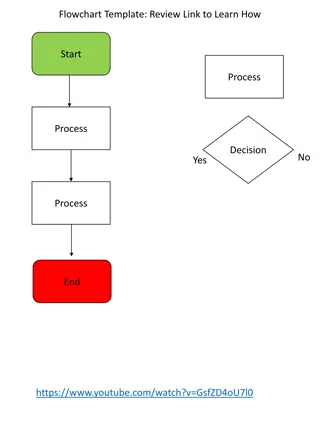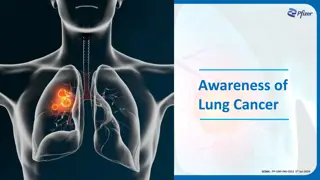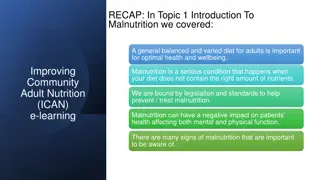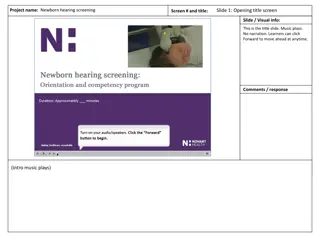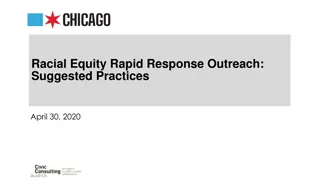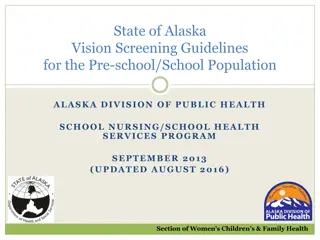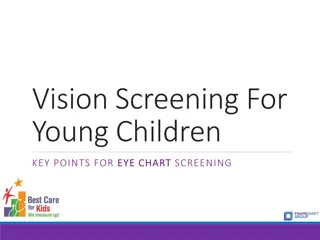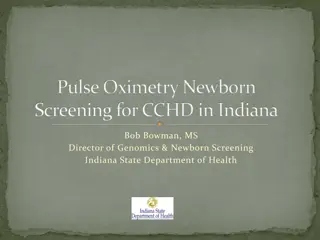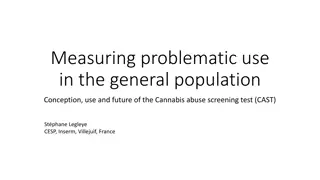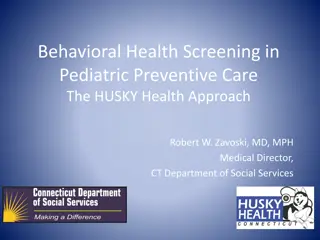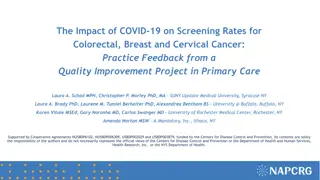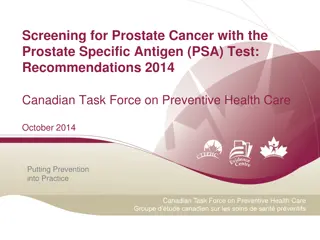Screening in Public Health - Objectives, Purposes, and Definitions
This content delves into the essential aspects of screening in public health, covering definitions, purposes, and comparisons between screening and diagnostic tests. It emphasizes the importance of early detection, risk factor identification, and the role of screening in reducing morbidity and mortality from diseases. The provided images and text offer insights into screening strategies, ideal test properties, and the interpretation of screening parameters.
Download Presentation

Please find below an Image/Link to download the presentation.
The content on the website is provided AS IS for your information and personal use only. It may not be sold, licensed, or shared on other websites without obtaining consent from the author.If you encounter any issues during the download, it is possible that the publisher has removed the file from their server.
You are allowed to download the files provided on this website for personal or commercial use, subject to the condition that they are used lawfully. All files are the property of their respective owners.
The content on the website is provided AS IS for your information and personal use only. It may not be sold, licensed, or shared on other websites without obtaining consent from the author.
E N D
Presentation Transcript
SCREENING Dr. Salwa A. Tayel & Dr. Mohammad Afzal Mahmood, Department of Family & Community Medicine (November, 2013) 4 April 2025 1
Objectives of the session By the end of the session the students should be able to; Describe the purpose of screening in public health Define main concepts of screening Describe strategies of screening List properties of an ideal screening test Interpret parameters used for assessment of screening tests 4 April 2025 2
HEADLINES Definitions Purposes of screening When do we screen ? Strategies of screening Properties of ideal screening Examples of screening tests Screening parameters 4 April 2025 3
Screening: Definition The EARLY DETECTION of Disease Risk factors Susceptibility to disease in individuals who do not show any signs of disease Goel 4 April 2025 4
Screening Test: Definition Screening test: specific technology (survey questionnaire, physical observation or measurement, laboratory test, radiological procedure, etc.) used to identify persons with unrecognized disease or unrecognized risk factors for disease. So it is applied to asymptomatic apparently healthy individuals. 4 April 2025 5
Purposes of Screening Identifying unrecognized disease (early stage) Identifying persons at increased risk for the presence of disease, who warrant further evaluation Classifying people with respect to their likelihood of having a particular disease Reducing morbidity and mortality from disease among persons being screened 4 April 2025 6
Diagnosis Screening Screening tests can also be used as to suspect the presence of a certain disease Such provisional diagnosis is subject to confirmation of presence or absence of disease Screening in Public Health is generally done at the population level populations where many are not suspected of having disease 4 April 2025 7
Comparison between screening and diagnostic tests Screening tests Done to those who are apparently healthy or asymptomatic Applied to a single person individuals Results are based on the evaluation of a number of symptoms, signs and investigations Results are conclusive and final Results are not conclusive More accurate Less accurate Diagnostic tests Done to those with suggestive signs or symptoms Applied to a group of Results are based on one criterion Less expensive More expensive Not a basis for treatment Basis for treatment 4 April 2025 8
Natural History of Disease Detectable subclinical disease Clinical Disease Stage of Recovery, Complications, Disability, or Death Subclinical Disease Susceptible Host Diagnosis sought Point of Exposure Onset of symptoms Screening 4 April 2025 9
Flow diagram for a screening program Population Screening test Test -ve Test +ve Diagnostic procedures (+ve) Affected (-ve) Unaffected Re-screen Treatment Re-screen 10 4 April 2025
Screening Strategies Population Approach High-Risk Strategy Relatively more cost-effective Intervention appropriate to the individual Subjects are motivated Fails to deal with the root causes of disease Small chance of reducing disease incidence Relatively expensive Small benefit to the individual Potential to alter the root causes of disease Poor subject motivation Large chance of reducing disease incidence 4 April 2025 11
Properties of Ideal Screening 1. Screening is simple, inexpensive, and easily diffused through the population. the test is acceptable to those who agree to be tested 2. The act of screening is safe and acceptable. 3. The screening test is reliable. 4. The screening test is accurate. 4 April 2025 12
Success of Screening Program Depends on: Target disease is common (high incidence/prevalence) Effective treatment and effective health system that is capable to reduce morbidity and mortality The Screening itself is Safe, Reliable, Acceptable, Relatively Inexpensive 4 April 2025 13
Examples of Screening Tests Questions e.g. maternal mental health Clinical Examinations Dermatological examination to screen for melanoma Laboratory Tests e.g. Thalassemia Genetic Tests e.g. screening among high risk to identify PKU carriers X-rays Breast cancer 4 April 2025 14
Validity of Screening Tests Validity tells us How accurate is the screening test as compared to the confirmatory diagnostic test or the Gold Standard test. Validity can be measured by: Sensitivity Specificity 4 April 2025 15
Results of a screening test compared to the gold standard True Disease Status Present a Absent b Screening a + b Positive Test c d c + d Negative N a + c b + d 4 April 2025 16
Results of a screening test compared to the gold standard True Disease Status Present Absent False True Screening Positive Test positives positives False True Negative negatives negatives 4 April 2025 17
Sensitivity Proportion of individuals who have the disease who test positive (a.k.a. true positive rate) tells us how well a + test picks up disease Disease yes no a = Sensitivity a c b d Screening a + b Test a + c + c + d - a + c b + d N 4 April 2025 18
Specificity Proportion of individuals who don t have the disease who test negative (a.k.a. true negative rate) tell us how well a - test detects no disease Disease d yes a c no b d = Specificity Screening a + b Test b + d + c + d - a + c b + d N 4 April 2025 19
Example Sensitivity: a / (a + c) Sensitivity = 90% i.e. Screening test will correctly identify 90% of all true cases. Specificity: d / (b + d) Specificity = 95% i.e. Screening test will correctly classify 95% of all non-cases as being disease free. 4 April 2025 20
Example Sensitivity: a / (a + c) = 90% False negative Rate=c/a+c=10/100=10% Specificity: d / (b + d) 95% False Positive Rate=b/b+d=5/100=5% 21 4 April 2025
Screening Principles Sensitivity the ability of a test to correctly identify those who have a disease a test with high sensitivity will have few false negatives Specificity the ability of a test to correctly identify those who do not have the disease a test that has high specificity will have few false positives 4 April 2025 22
Yield (Predictive values) Yield is the amount of previously unrecognized disease that is diagnosed and brought to treatment as a result of screening. It is measured by: Positive Predictive Value (PPV) Negative Predictive Value (NPV) 23 4 April 2025
Positive Predictive Value Proportion of individuals who test positive who actually have the disease i.e. The ability to predict the presence of disease from test results. Disease a yes a c no b d = P.P.V. Screening a + b Test a + b + c + d - a + c b + d N 4 April 2025 24
Negative Predictive Value Proportion of individuals who test negative who don t have the disease i.e. The ability to predict the absence of disease from test results. Disease d no yes a c = N.P.V. b Screening a + b c + d Test + d c + d - a + c b + d N 4 April 2025 25
Example P.P.V. =19/118=16% Among persons who screen positive, 16% are found to have the disease. N.P.V. = 1881/1882=99.99 Among persons who screen negative, 99.9% are found to be disease free. 26 4 April 2025
Example P.P.V. = 57/59=96.6% N.P.V. = 38/41=93% 27 4 April 2025
Factors affecting the PPV/NPV of a screening test Sensitivity = 95% Sensitivity = 95% Specificity =95% Specificity =95% Prevalence=1% Prevalence=60% 4 April 2025 28
Factors affecting the yield of a screening test Prevalence (%) Sensitivity Specificity PPV 0.1 90% 95% 1.8% 1.0 90% 95% 15.4% 5.0 90% 95% 48.6% 50.0 90% 95% 94.7% 29 4 April 2025
Factors affecting the yield of a screening test Sensitivity: Specificity: Prevalence: PPV is maximized when used in high risk populations since the prevalence of pre-clinical disease is higher than in the general population. screening a total population for a relatively infrequent disease can be very wasteful of resources and may yield few previously undetected cases.
Net effects from screening 1. True positives are exposed to the costs, inconvenience, and hazards of screening, follow-up diagnostic evaluations, and therapeutic interventions. Only true positives have an opportunity to benefit from medical therapy. 2. True negatives are exposed to the costs, inconvenience, and hazards of screening. True negatives may be reassured by knowledge of a negative screening test result. 4 April 2025 31
Net effects from screening 3. False positives are exposed to the costs, inconvenience, and hazards of screening and follow-up diagnostic evaluations. The falsely positive screening test result may cause psychological and emotionaldistress. 4. False negatives are exposed to the costs, inconvenience, and hazards of screening. False negatives may be falselyreassured by knowledge of a negative screening test result. False negatives represent lost opportunities to prevent adverse outcomes from disease. 3,4 are called adverse effects or errors of screening 4 April 2025 32
A test is used in 50 people with disease and 50 people without. These are the results. Disease Present Absent Screening 48 3 51 Positive Test 2 47 49 Negative 100 50 50 4 April 2025 33
Disease Present 48 Absent 3 51 Screening Positive Test 2 47 49 Negative 100 50 50 Calculate: Sensitivity Specificity Positive Predictive Value Negative Predictive Value 4 April 2025 34
References Raffle A, Gray M. Screening: Evidence and practice. Oxford: Oxford University Press, 2007 Songer T. Screening and its useful tools. South Asian Cardiovascular Research Methodology Workshop Weissfeld JL. Screening and early detection 4 April 2025 35


